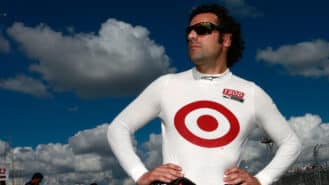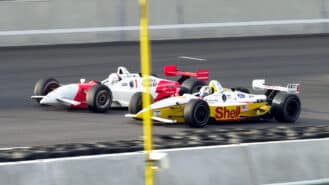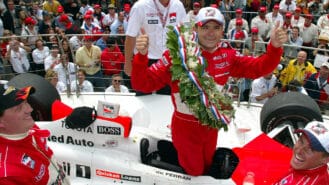Ninety years ago, Tommy Milton and Jimmy Murphy were the men to beat in what was then known as AAA championship racing. Blind in one eye from birth, Milton won the Indianapolis 500 in 1921 and ’23, plus 21 other AAA championship races between 1917-25. He also won the AAA title in 1920 and ‘21. Murphy was Milton’s protégé who won the 1922 Indy 500 plus 18 other AAA races between 1920-24. He also posthumously won the 1924 AAA title.
Like most of the great drivers from that era, Milton and Murphy were first-rate mechanics and self-taught engineers. At Daytona Beach in April 1920 they shared a twin-engined Duesenberg designed by Milton to break the Land Speed Record. They became the first men to break the 150mph barrier on land, while Murphy went on to score a historic victory in the 1921 French GP with the factory Duesenberg team. Jimmy’s win (below) was the first all-American victory in Grand Prix racing – a feat that would not be duplicated until Dan Gurney won the 1967 Belgian GP aboard his own Eagle-Weslake.

The 1920 Indy 500 had been won by Gaston Chevrolet’s Monroe/Frontenac. Chevrolet also won that year’s AAA crown posthumously following an accident during the season-closer at the 1.25-mile Beverly Hills board track. Seven years later the AAA revised its historic record, adding five races to the 1920 series and declaring Milton that year’s champion. These revised rankings made Murphy the championship runner-up and dropped Chevrolet to third.
Milton had joined the Frontenac team for 1921, taking over Chevrolet’s seat and comfortably winning the Indy 500 after Ralph De Palma’s Ballot blew its engine. Murphy crashed out of the race, but the following month the Duesenberg team sailed to France to compete in the Grand Prix where Murphy scored his historic win. In doing so Murphy and the Duesenberg team missed three AAA races and Milton built an insurmountable championship lead. He won that year’s title, with Murphy fourth in the points. Milton reached his goal aboard a variety of cars, driving his own Durant with both Duesenberg and Miller engines as well as a factory Frontenac.
Milton’s results prompted Murphy to buy a Miller engine and install it in his Duesenberg, creating the Murphy Special. In this car he dominated the 1922 Indy 500, qualifying on pole and leading most of the race to win at record speed. Murphy easily beat Milton to the championship, winning seven races to Milton’s four.

Courtesy of Indianapolis Motor Speedway
In 1923 Milton (above) was on pole at Indianapolis and led most of the way to win, with Murphy finishing third, but neither enjoyed very good seasons. Murphy won two early-season races but his title challenge was blunted by another foray to Europe to compete in the Italian GP at Monza, where he finished third. He was beaten to that year’s AAA title by Eddie Hearne, while Milton failed to win another race after Indy and came fifth in the points.
The following year Murphy qualified on pole at Indy and led the race before being overwhelmed by Joe Boyer in one of the new supercharged Duesenbergs. Veteran Earl Cooper finished second as Murphy fell to third because of tyre troubles. But after Indy Murphy won three races in a row and took control of the championship before losing his life in a dirt track race at Syracuse, New York in September. So dominant was Murphy that he was declared the champion even though there were still three races left to run after his death.
Milton continued to race until 1927. He won the season-opener in 1925 and finished second to Pete de Paolo in that year’s championship but wasn’t a serious factor in the following two years before retiring. Milton was chief steward at Indianapolis for many years but died from self-inflicted gunshot wounds in 1962, aged 68, after suffering in his later years from burns received in a 1919 accident.






